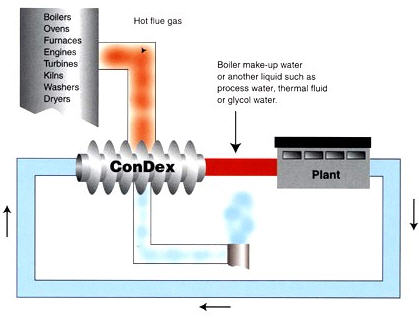Introduction
Air has a relatively low energy density – which means that it takes a LOT of it to contain any significant amount of energy. This is the primary reason why it can be expensive to recover heat from air. The best applications are where the air temperature is very high (over 1,000°F) and there is a high volume already at one location. Ducting to a common spot is an option, but high temperature ducting adds substantially to the installation cost and the cost to move that air to the central location.
Industrial process air may contain contaminates that will make it more difficult to recover the energy.
Operation
Air-to-Air
Air-to-Air heat recovery in high temperature applications is the most common on gas burners used on high temperature ovens, such as heat treating, incinerators, kilns, metal melting and glass melting. ‘Regenerative Burners’ are installed in pairs; the exhaust gas of one burner is used to pre-heat a thermal mass that is used to pre-heat combustion air for the other burner. For larger burners, the exhaust is ducted to the mass so that the burner’s own exhaust pre-heats its combustion air.
The higher the combustion air temperature, the higher the combustion efficiency. Most burners can be retrofitted for a small amount of heat recovery. Not all burners are designed to use high temperature combustion air.
As fuel prices increase (and stay high for longer periods of time) it becomes more economical to install heat recovery burners on lower temperature applications, more common to the food processing industry.
Air-to-Liquid
The most common air-to-liquid heat recovery systems is the Heat Recovery Steam Generator (HRSG – pronounced HeRSiG) used in combined cycle combustion turbines and engine-driven cogeneration (on-site electric power production) systems to produce steam. The steam is then used in a steam turbine to produce additional electricity or directly in a steam process.
The liquid may also be thermal oil or thermal fluid. An example is an asphalt plant that uses waste heat recovery off the gravel dryer to heat thermal fluid used to heat the thick oils used to make the asphalt. Thermal fluid is used in a wide range of industrial processes from plastics and wood plants to food processing, where high temperature is needed (above 500F) but high pressure is not needed or desired – as would result with heating water. Fryers are the most common application of thermal oil systems in the food processing industry.
More Information
Manufacturers
 Combustion & Energy Systems, Ltd
Combustion & Energy Systems, Ltd
25 Royal Crest Court,Suite 110
Markham, Ontario
Canada L3R 9X4
Telephone: 905-415-9400
Go to their web site at www.outer-net.com
With over ONE-BILLION BTU’s of heat recovery equipment installations, Combustion & Energy Systems has established itself as a recognized designer and manufacturer of quality heat recovery systems. We have been serving industrial customers for over 20 years providing equipment solutions to heat transfer problems.
Introducing ConDex, the breakthrough energy saving technology from Combustion & Energy Systems. ConDex can be applied to boilers (150 hp to 500,000 lb/hr) and process equipment (3,000,000 to 500,000,000 Btu/hr).
ConDex is so effective the payback period could be as short as six months – and the savings are guaranteed *.
Sources: Text Bob Fegan 10/2005; images from manufacturer’s web sites referenced and linked above;
